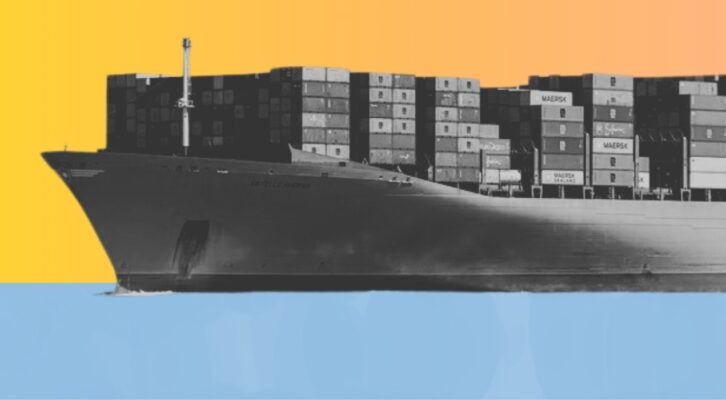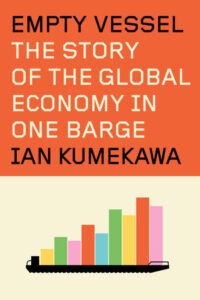
What the Voyage of a Single Container Ship Reveals About the World Economy
Ian Kumekawa Explores the Transformation of Global Trade Through the Objects That Power It
On a spring day in 1989, a container ship arrived in New York harbor from Eemshaven, a deepwater port in the Netherlands. The Vessel, named the Bibby Resolution, belonged to a well-established Liverpool shipping line, one whose founder had invested in the Atlantic slave trade two hundred years before. But while the company that owned it had a history that went back centuries, the ship itself was unmistakably a product of the late twentieth century.
The Vessel was assembled out of standardized parts developed for streamlining oceanic trade. It was a global polyglot: manufactured in Sweden, it had a British owner and an international crew. In the decade since its launch, it had been registered in four different countries. At the time it moored in New York, the Vessel was listed in the Bahamas, though it had never physically been close to Bahamian waters. Like other container ships, the Bibby Resolution was a creature not so much of a single country but of a global economic order.
The Bibby Resolution was an unusual container ship. For one thing, it did not have an engine; it had been transported to New York from Europe on the back of another ship. For another, the containers the Vessel carried were never intended to be unloaded, nor were they meant to contain merchandise. The Vessel was an accommodation ship: in the various descriptions of its owners, a “hotel ship,” a “coastel,” or a “floatel.” These designations were meant to evoke comfort, if not luxury. But they did not change the fact that the Vessel was a simple ninety-four-meter-long flat-bottomed hull with a modular five-story steel “accommodation block” mounted on its deck.
The Vessel’s story offers a window onto the profound and dynamic changes that have buffeted and shaped the world economy over the past forty years.
For though the Vessel was built to house people rather than to transport goods, it was still very much a container ship. Its cabins and galleys, its gathering spaces and recreation rooms, were assembled out of modified steel shipping containers. And it had been brought to New York quite literally to contain. The New York City Department of Correction had leased the Bibby Resolution to serve as a floating jail.
*
And so, in addition to being a ship, the Vessel was also a jail, at least for the five years that it was in New York. At other points in its history, it was a barracks for troops in the Falkland Islands, temporary housing for assembly line workers in West Germany, and a home away from home for oilmen off the coast of Nigeria. Over the past four decades, the Vessel has been called many names: the Bibby Resolution, the Safe Esperia, Her Majesty’s Prison The Weare, even “The Love Boat.” Today, it goes by the unassuming name of the Jascon 27, a reference to a company that once had title to it. It has flown the flags of five different countries, known a litany of owners, and, though it has never had a motor of its own, traveled tens of thousands of miles.
The ship at the heart of this story has both lived and contained many lives. In and of itself, the Vessel is uncharismatic. In the description of one of its early owners, it looks “like a big shoebox.” Even its technical classification—“dumb pontoon”—evokes a hulking, silent presence. But although it may outwardly appear stolid and static, the Vessel’s story offers a window onto the profound and dynamic changes that have buffeted and shaped the world economy over the past forty years.
Moreover, it has been a repository for the effects of such changes, as well as a stage on which they have played out.
The barge was manufactured to be modular and adaptable. It is this adaptability that has given it value. As Britain’s former chief inspector of prisons, Ann Owers, noted in the early 2000s, the barge was first and foremost a “container.” Its meaning and function changed depending on what, or who, it contained. In the North Sea and in Nigeria, it was an offshore oil service vessel; in the Falklands it was a barracks; in New York it was a jail. The fact that the Vessel could be filled allowed it to be transformed and take on meanings that fit its setting. In this way, its emptiness has been its defining characteristic.
For this reason, throughout its existence, the barge has always been passive. It has been forged and reforged, swept along and buffeted by a set of profound and interrelated economic transformations: the growth of the carbon economy, globalization, financialization, mass incarceration. In the process, it has also become the setting against which such sweeping processes played out. Built to service the global, multinational energy industry, it was deployed in the South Atlantic as part of an effort to shift British political attention away from the widespread unemployment caused by Margaret Thatcher’s government. Later, it was rushed to New York to accommodate a swelling jail population, itself precipitated by the rising unemployment and shrinking social services of the Reagan years. All the while, the Vessel was privately owned, successively registered in tax haven after tax haven.
The barge has been an abstract financial object; its ownership was divided up and leveraged, used to guarantee international corporate bonds. It has also been an abstract legal object: haggled over in arbitration tribunals in London and the British Virgin Islands and the subject of an important case in English commercial law. It was built largely because of an innovation in the international law of the sea, and first acquired as a way to circumvent Norwegian tax laws. Its registration and ownership depended on other international treaties and national tax codes. As a penitentiary and workplace, the Vessel became a stage for the enactment of other kinds of law. As such, it became a site of the abstract forces that have transformed our world over the past forty years.
*
So much of the language around globalization and economic transformation is abstract. It “extends” markets; it “deregulates” oversight; it “financializes” physical goods. Not coincidentally, in the United States and western Europe, one of the effects of a wide range of disparate policies and agendas often lumped together as “neoliberal” has been to drive traditional manufacturing jobs overseas while undergirding the growth of the financial sector. And financialization itself necessarily involves abstraction; it did so when grain traders developed the futures market in Chicago in the late nineteenth century, and it still does so today. The vessel that this book follows belongs to this world. It is, quite literally, offshore. It was constructed from modular shipping containers, conceptualized in terms of empty, fillable volume. It is a creation of a supernational, offshore global order: registered in the Bahamas or St. Vincent and the Grenadines, owned by international consortia, leveraged by financiers in London, Oslo, and Lagos.
The barge serves as a reminder that all economic transformations depend on material processes.
But the barge was—and remains—fundamentally an object. Normally, the physical dimension of globalization remains in the background, relatively unnoticed. It usually takes catastrophe—a very physical breakdown, like the mega container ship Ever Given blocking the Suez Canal in 2021, or the Russian blockade of Ukrainian grain ports on the Black Sea—to cast a spotlight on the physical infrastructure that undergirds the world economy. This book attends to the extreme physicality of abstract processes. Despite the great degree to which the Vessel’s story has been intertwined with the history of economic and legal abstraction over the past forty years, the barge itself is inescapably concrete.
It is a physical object: a vessel made of steel weighing 9,500 deadweight tons. It took shape only as Swedish builders welded and riveted it together, piece by piece. It has gangplanks and bulkheads, a sewage treatment plant and noisy Volvo generators. Even when it was moored in New York’s East River, it swayed and rocked. It housed up to nine hundred people, who ate, washed, and slept in claustrophobic proximity, using sturdy metal furniture and a vacuum toilet system that was prone to malfunction. And its physical condition deteriorated. Every few years, it needed to be removed from the water and refurbished, barnacles scraped from the hull, its decks cleaned and repainted.
The barge serves as a reminder that all economic transformations depend on material processes. And its story brings to light the very real and very physical effects of the transformation of the world economy over the past four decades. These effects are messy, far from gleaming shopping malls, glassy office blocks, and slick websites rendered in clean sans serifs. And though they are frequently hidden from public view, the physical effects are fundamental to the processes that have altered our world. Deregulation in the 1980s was enabled by the calculated exercise of military power. The economic dislocations of financialization accelerated mass incarceration and the physical detention of millions of people. The provision of global energy supplies continues to depend on the extraction of fossil fuels from deep beneath the earth and sea. Training sophisticated artificial intelligence depends on huge amounts of energy: creating a single moderately sized AI model can emit as much carbon as several cars in their lifetimes.
__________________________________

From Empty Vessel: The Story of the Global Economy in One Barge by Ian Kumekawa. Copyright © 2025. Available from Alfred A. Knopf, an imprint of Knopf Doubleday Publishing Group, a division of Penguin Random House, LLC.
Ian Kumekawa
Ian Kumekawa is a historian at the Center for History and Economics at Harvard University. He is the author of The First Serious Optimist: A. C. Pigou and the Birth of Welfare Economics (2017), which won the Joseph J. Spengler Prize. He has taught at Harvard and MIT. He hails from Clinton, CT and now lives in Boston.



















